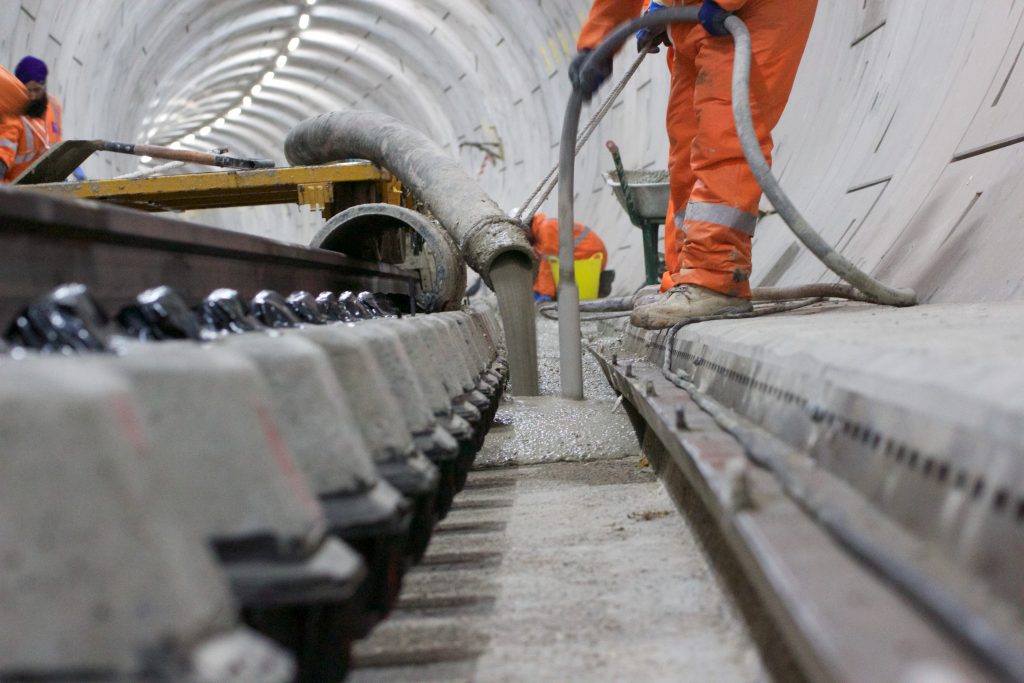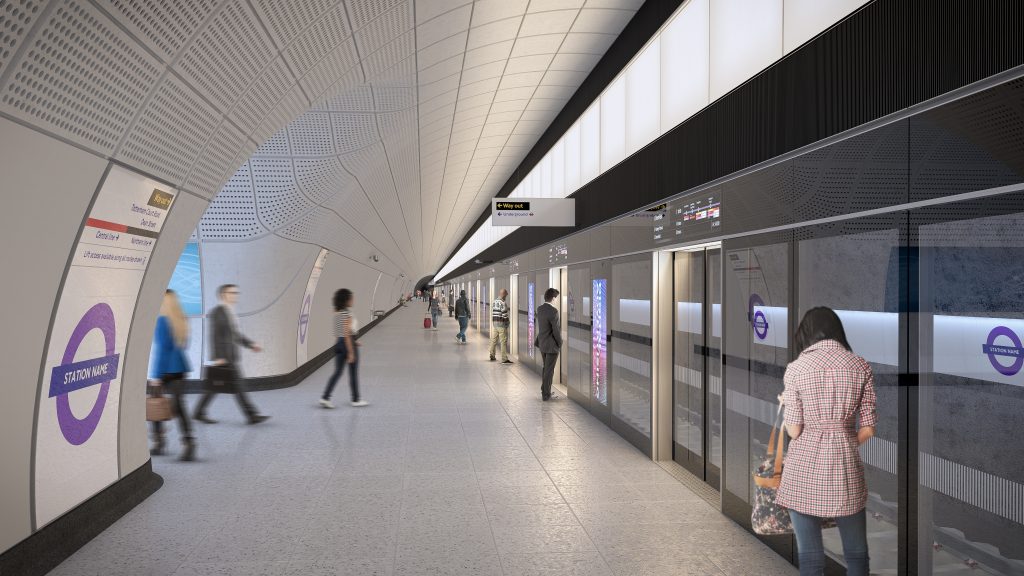As autumn approached, Crossrail announced that, following a very intense and busy period, the project had reached yet another milestone – declaring that 75 per cent of the work was now complete. To understand better just what “75 per cent complete” actually means for the engineers involved, Rail Engineer caught up with Chris Binns, chief engineer for the £14.8 billion project.
First, a recap on the project. Crossrail extends from Reading and Heathrow in the west to Abbey Wood and Shenfield in the east, a route that is 118km long. It includes a new central core consisting of 42km of new bored tunnels.
There are 40 stations on the route, including 10 new Crossrail stations that are entering their final stages of construction. Some are in very complex locations – Paddington, Bond Street, Whitechapel and Liverpool Street to mention a few. In addition, there are complex, redesigned track layouts both west and east of the capital.
Bombardier is currently building 66 new trains at its factory in Derby. Each train is 200 metres long and designed to carry 1,500 passengers. The first trains are now coming off the production lines for trials and testing, ready to be introduced to services on the route between Liverpool Street and Shenfield by May 2017. This deadline will be followed by further targets of May 2018 from Heathrow to Paddington then Paddington to Abbey Wood by December 2018.
Myriad of system interfaces
More than 35km of permanent track has been installed inside the new tunnels and the fitting out of the mechanical and electrical equipment for the stations, signalling systems and power supplies is now well underway.
Engineering teams are being refocussed and are slowly moving away from production issues toward the intricate requirements associated with the testing and commissioning regime. Not only do the myriad of system interfaces need to be tested in the new tunnels but also with the different Network Rail environments both east and west of the capital.
Chris was keen to point out that none of the fitting-out work of tunnels and stations can be carried out without the skill and support of a competent and innovative supply chain.
Back in April 2013, Crossrail awarded the last major suite of contracts, valued at £300 million, to a joint venture comprising Alstom Transport, Costain and French track work specialist, Travail Sud Ouest (TSO). Normally referred to as ATC JV, it is the joint venture’s responsibility to ensure that the tunnels are fitted out with the necessary equipment for an operational railway system.
When the tunnels were completed, the construction included a mass concrete base ready to receive the various track slab designs. The base has a raised curb either side, which can carry a specially built multi-purpose gantry. There are four gantries working on the project and each one has the capacity to carry and position 28 sleepers at a time ready to receive new continuously welded rail.
A total of 70,000 sleepers are being installed. These are manufactured in Nottingham by SBC Rail and then stockpiled in bales at the railhead depots at Plumstead Logistics Centre in south east London and Westbourne Park temporary railhead in West London. Both locations are being used throughout the contract for providing engineer trains and for storing materials and equipment. The Plumstead railhead is going to be the permanent infrastructure maintenance depot for Crossrail.
British Steel is supplying more than 57km of heat- treated, wear-resistant rail. The steel blooms are produced in its Scunthorpe plant but the slight surprise is that these blooms are then transported to Tata’s Hayange mill in northern France to be rolled and finished. Apparently, that’s where the heat-treatment furnaces are.
Heavy and light track slab
Chris stated that about 64 per cent of the track required in the tunnels has been installed. This is not an easy calculation because there are five different types of track being used, including:
- Standard slab track which forms 80 per cent of the track on the new railway – 70 per cent complete;
- Direct fixed track using Australian Delkor two-holed baseplates to reduce dynamic stresses and installed throughout the Victorian Connaught Tunnel – 100 per cent complete;
- High-attenuation sleepers, similar to standard slab track, used in a few areas where noise and vibration need to be kept to a minimum – 25 per cent complete; » Floating track slab light, used to reduce noise and vibration in the Soho area – 50 per cent complete.
- Floating track slab heavy, with a high iron ore content which doubles the density of normal concrete, is being used in the most sensitive areas such as under the Barbican Centre – work just starting.
ATC JV also invested in a refurbished concreting train in August 2015. It is a 465-metre-long mobile underground concrete batching factory using dry materials. Chris explained that running and maintaining the concreting train is a 24-hour operation. Concrete pouring takes place during the night with restocking and maintenance carried out during the day.The train has piping running from the front of the train, like a giant insect proboscis, for about 300 metres. This means that the train does not have to run on freshly laid concrete the next day, thus allowing the concrete adequate time to gain strength.Based at the Plumstead rail depot, the train is being used for the construction of standard track slab with a peak production rate of 377 metres in a seven-hour shift.
Turning a train
One disadvantage to the train, that Chris pointed out, is that it is designed to European gauge. So, when needing to turn the train to go in a different direction, they couldn’t just run it round a triangle. Instead, they had to lift each of the 23 wagons on to a low loader, turn it around using the gantry crane in Plumstead rail depot and then put it back on the tracks. This process took three weeks to complete. Fortunately, it was something that had been planned for! A different, smaller concreting train, known as the Shuttle, was also brought into action in January 2016. Chris explained that the Shuttle is being used to construct the standard track slab in the tunnels from the Royal Oak Portal through to central London.
The Shuttle train uses batches of ready mixed fibre reinforced concrete so time becomes an even more critical factor in the process.
High welding standard
Long welded rail trains are being used to install the continuously welded rail which is being welded together using a Plasser & Theurer road-rail flash butt welding machine, acquired by the ATC joint venture. It is specially designed to produce welds to a consistently high standard in a tunnel environment.
As part of the tunnel fit-out, it has been estimated that more than 250,000 holes will need to be drilled to accommodate brackets for cabling, walkways and other equipment to support the operation of the railway. A state of the art drilling rig, owned by ATC JV and manufactured by Rowa Tunnelling Logistics in Switzerland, is now being used to drill the majority of the holes, thus minimising the need for manual drilling.
Once the track slab has been laid, the rig sits on the track and moves through the tunnels, drilling the holes in pre-determined locations.
The machine has a dust suppression system in place, helping to produce a clean and accurately drilled hole every time. The rig is configured to work in conjunction with real-time 3D laser surveys of the tunnel to ensure accuracy. To date, approximately 25 per cent of the holes required to fix walkways, cable troughs and other equipment have been drilled and it is proving to be an invaluable piece of equipment for all concerned.
Platform screen doors
More than 92 per cent of the platforms being built in the central section are completed and 93 per cent of the platform edge screen fixings that will incorporate the platform screen doors, passenger information screens and advertising space are in place. The first prototype of the platform screen doors has been manufactured at Knorr-Bremse’s workshops in Melksham, Wiltshire.
Three rail wagons, adapted from a shipping container design, are employed to install the door panels. Each wagon carries three panels, which are brought to the station platform along the tracks using a road/rail machine and then the units are just hydraulically slid into place. It is a very impressive engineering process.
A continuous band of lighting is incorporated into the top of the door panels so that the light is reflected off the curved fibreglass-reinforced concrete panels that form the cladding for the walls and roof of the station platforms. It looks good, and it is interesting to note that 96 per cent of Crossrail contracts have been placed with companies based in the UK, Knorr-Bremse in Wiltshire being one of them.
The Crossrail route will be powered by a 25kV overhead line system using a Cariboni 110mm deep rigid overhead conductor bar throughout the tunnels. Although from a different manufacturer, this design concept is similar to the one being installed in the Severn Tunnel that doesn’t require weights and pulleys.
In the central section, 25kV traction power for the Crossrail trains will be provided by two new bulk supply points from National Grid 400kV, at Pudding Mill Lane in the east and Kensal Green to the west. Super grid transformers have been installed and fitted with fans and additional coolants.
A 22kV high-voltage network will be installed in the central section from Royal Oak Portal in the west to Limmo Peninsula in the east with an 11kV high-voltage non-traction spur to be installed from Limmo through to Plumstead. This network will supply mains power to each Crossrail station, shaft and portal within the central section.
Copenhagen trial
When the new Elizabeth line opens, 24 trains per hour will operate in each direction through the centre of London. The new signalling system will incorporate Automatic Train Operation to support this service, with the capacity for higher frequency of 30 trains per hour in the future. As a consequence, Siemens is installing the Communications-Based Train Control system (CBTC). It is similar to one already successfully installed in Copenhagen, so expectations are high.
Chris was off to a meeting to review testing and commissioning plans and procedures. The emphasis is slowly changing from “how should we build it” to “how do we make sure it all works together?”
The teams are having to adapt to the new challenges of assurance but, clearly, the scale of these challenges will remain high. It appears to be a situation that Chris and his team are relishing, but the clock is ticking with just over 300 days to go before tests start in November 2017.




